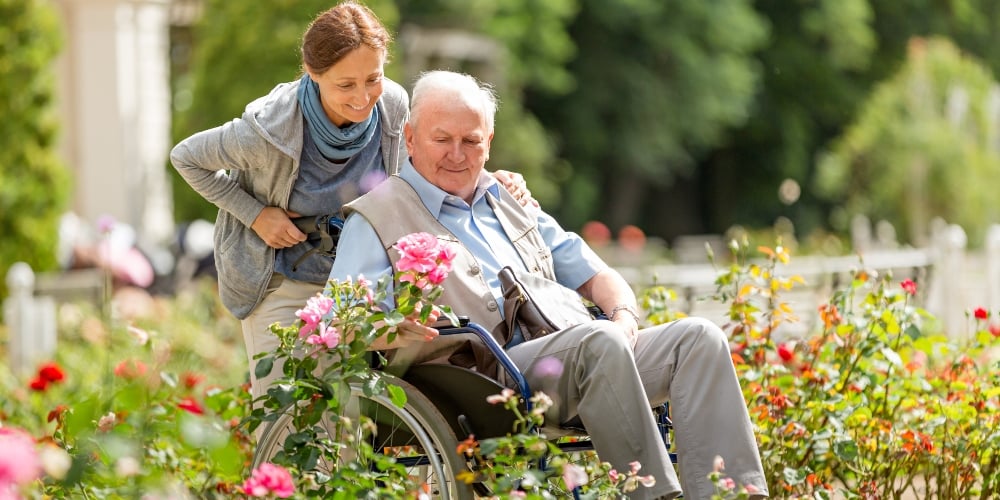Our Highgate Senior Living communities reside in cities, so we anticipate concerns from both seniors and their families about getting outside. Is outdoor activity potentially harmful?
Yes, when there’s an air quality alert. However, when the weather’s good, getting outdoors is good for both brain and body.
Studies show there aren’t as many benefits if our residents stroll through the houses or businesses in the neighborhood. However, when activities move to one of our city’s green spaces, it can up the benefits to mind and body significantly.
Benefit #1: More Emotional Rewards
After reviewing 11 trials, the National Institutes of Health (NIH) concluded that, “Compared with exercising indoors, exercising in natural environments was associated with greater feelings of revitalization and positive engagement, decreases in tension, confusion, anger, and depression, and increased energy.”[1] There are 11 studies all saying the same thing. Nature is where your brain and body recharge best.
Another study confirms this conclusion as well. It found that vitality increased more when participants exercised outdoors versus indoors. Another interesting result seen in the same study was the difference between how participants evaluated how much vitality they felt after walking among buildings versus natural spaces.[2] Something about natural environments recharges emotional and physical energy banks more.
What John Muir wrote over 100 years ago is scientifically provable.
“Climb the mountains and get their good tidings. Nature’s peace will flow into you as sunshine flows into trees. The winds will blow their own freshness into you, and the storms their energy.’’
With rewards like that, it’s easier to want to get out more often.
Benefit #2: Variation
Sure, a treadmill is better than no exercise. And the monotony of going nowhere can be broken by watching TV. However, our brains are crying for more than variation in what we see. Our bodies are craving variety in our movements. It wants us to use all our muscles, something a treadmill doesn’t facilitate.
Three miles of walking outdoors is likely to burn more calories just because the terrain is uneven, and the wind creates forces our bodies must respond to. Walking outdoors also ensures we alternate between different muscle groups. A set of stairs, stepping off the curb to cross the street, up or down slopes—these all switch up which muscle groups we use as we walk. These different ‘obstacles’ also change which type of muscle contractions we’re using. Concentric contractions shorten and generate force, while eccentric contractions elongate the muscle.
This variety is especially important for seniors, because overworking one muscle group can lead to days of sleep-interrupting pain. Poor sleep hurts memory!
Benefit #3: Improvements to Blood Lipids and Glucose Metabolism
Whether we’re walking in the park or on a treadmill, we’ll see benefits. However, outdoor walking offers one benefit a treadmill cannot. One study in Austria demonstrated that walking downhill for one hour clears more glucose out of the bloodstream than an hour hiking uphill. Treadmills aren’t geared for downhill action. So if diabetes or pre-diabetes is an issue, it’s useful to know that outdoor time walking downhill almost doubles glucose tolerance.[3]
Benefit #4: Fresh Air
Severe allergies or smog aside, the fresh air and sunshine the park offers is a boon to overall health. Oxygen isn’t the only gas we breath indoors. There are many other gases as well—some potentially hazardous to health. Unless there’s an air quality warning in effect, the air outdoors contains fewer harmful gases than the air indoors.
This occurs for two reasons. There are plants outside that absorb toxic gases, and there are air currents which diffuse them. While we make every effort to ensure Highgate’s indoor spaces meet healthy air quality standards, it’s impossible to improve upon nature’s great air filtering system.
Benefit #5: Sunshine
When exercise falls outside of the hottest times of the day, sunscreen isn’t necessary. This helps our bodies produce the most active type of vitamin D—a vital nutrient for strong bones and a healthy immune response.
There’s also another benefit to sun exposure—mood improvement. Natural sunlight brightens the outlook on life, because it contains a balanced blend of the color spectrum. That can help our bodies fall into a natural circadian rhythm, which improves the ability to sleep deeply.
Benefit #6: Stronger Focus
Struggling to keep organized is a common problem. Outdoor exercise can help. If the people in a 2004 study reduced their ADHD symptoms by hiking, it’s likely to help anyone who is struggling to stay focused.
[1] http://www.ncbi.nlm.nih.gov/pubmed/21291246
[2] http://selfdeterminationtheory.org/SDT/documents/2010_RyanWeinstenEtAl_JEVP.pdf
[3] http://www.active.com/articles/study-looks-at-benefits-of-uphill-downhill-walking





